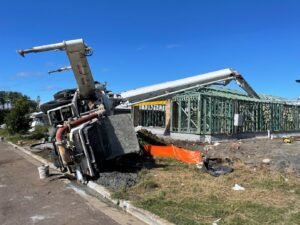Protecting workers from falls
2 min readOSHA issued new rule on Walking-Working Surfaces and Personal Fall Protection Systems will keep workers safer and provide greater flexibility for employers in General Industry.
 Final Rule to Update General Industry Walking-Working Surfaces and Fall Protection Standards
Final Rule to Update General Industry Walking-Working Surfaces and Fall Protection Standards
Falls from heights and on the same level (a working surface) are among the leading causes of serious work-related injuries and deaths. OSHA has issued a final rule on Walking-Working Surfaces and Personal Fall Protection Systems to better protect workers in general industry from these hazards by updating and clarifying standards and adding training and inspection requirements.
The rule affects a wide range of workers, from painters to warehouse workers. It does not change construction or agricultural standards.
The rule incorporates advances in technology, industry best practices, and national consensus standards to provide effective and cost-efficient worker protection. Specifically, it updates general industry standards addressing slip, trip, and fall hazards (subpart D), and adds requirements for personal fall protection systems (subpart I).
OSHA estimates that these changes will prevent 29 fatalities and 5,842 lost-workday injuries every year.
Benefits to Employers
The rule benefits employers by providing greater flexibility in choosing a fall protection system. For example, it eliminates the existing mandate to use guardrails as a primary fall protection method and allows employers to choose from accepted fall protection systems they believe will work best in a particular situation – an approach that has been successful in the construction industry since 1994. In addition, employers will be able to use non-conventional fall protection in certain situations, such as designated areas on low-slope roofs.
As much as possible, OSHA aligned fall protection requirements for general industry with those for construction, easing compliance for employers who perform both types of activities. For example, the final rule replaces the outdated general industry scaffold standards with a requirement that employers comply with OSHA’s construction scaffold standards.
Timeline
Most of the rule will become effective 60 days after publication in the Federal Register, but some provisions have delayed effective dates, including:
- Ensuring exposed workers are trained on fall hazards (6 months),
- Ensuring workers who use equipment covered by the final rule are trained (6 months),
- Inspecting and certifying permanent anchorages for rope descent systems (1 year),
- Installing personal fall arrest or ladder safety systems on new fixed ladders over 24 feet and on replacement ladders/ladder sections, including fixed ladders on outdoor advertising structures (2 years),
- Ensuring existing fixed ladders over 24 feet, including those on outdoor advertising structures, are equipped with a cage, well, personal fall arrest system, or ladder safety system (2 years), and
- Replacing cages and wells (used as fall protection) with ladder safety or personal fall arrest systems on all fixed ladders over 24 feet (20 years).

 Final Rule to Update General Industry Walking-Working Surfaces and Fall Protection Standards
Final Rule to Update General Industry Walking-Working Surfaces and Fall Protection Standards

